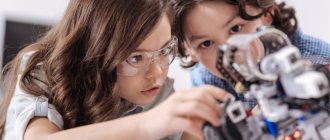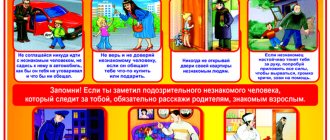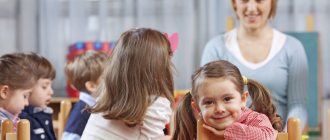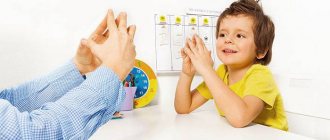“Round table” with parents of the senior group “Age characteristics of children 5-6 years old”
4
From the age of 5, a child begins to adequately evaluate the results of his participation in competitive games. Satisfaction with the result begins to bring joy to the child, promotes emotional well-being and maintains a positive attitude towards oneself. Preschoolers master complex constructive toys, including computers. On the street, preference is given to playing sports.
PRODUCTIVE ACTIVITIES:
In visual arts, children can draw narrow and wide lines with paint (with the end of the brush and flat), draw rings, arcs, make a triple stroke from one point, mix paint on the palette to obtain light, dark and new shades, whiten the main tone to obtain a lighter one shade, apply one paint to another. Children enjoy tracing the drawings along the contour and shading the figures. The age of 5-6 years is the age of the most active drawing. Over the course of a year, children are able to create up to 2 thousand drawings. The drawings take on a plot character. The image of a person becomes more detailed and
proportional. From the drawing one can already judge gender and emotional
the state of the person depicted. Children 5-6 years old are able to sculpt from a whole piece of clay (plasticine), modeling the shape
with your fingertips, smooth out the joints, pull parts away from the main shape with your fingers, decorate your work with stacks and moldings, and paint them.
Practical skills in working with scissors are improved: children can cut circles from squares, ovals from rectangles, transform some geometric shapes into others: a square into several triangles, a rectangle into stripes, squares and small rectangles; create images of various objects or decorative compositions from cut-out figures.
SOCIAL DEVELOPMENT:
At the age of 5 to 6 years, changes occur in the child’s ideas about himself: the assessment and opinion of his comrades become significant for them. The selectivity and stability of relationships with peers increases. Children explain their preferences by the success of a particular child in the game (“It’s interesting to play with him,” etc.) or his positive qualities (“She’s good,” “He doesn’t fight,” etc.). Children's communication becomes less situational. They willingly talk about what happened to them: where they were, what they saw, etc. Children listen carefully to each other and emotionally empathize with their friends’ stories.
At this age, the child develops a system of primary gender identity based on essential characteristics (feminine and masculine qualities, features of the manifestation of feelings, emotions, specific behavior, appearance, profession). When justifying their choice of peers of the opposite sex, boys rely on qualities of girls such as beauty, tenderness, affection, and girls rely on qualities such as strength and the ability to stand up for another.
Gross motor skills become more perfect: the child runs well on his toes, jumps over a rope, alternates on one leg and the other, and rides a two-wheeled bicycle. Complex movements appear: he can walk along a narrow bench and even step over a small obstacle; knows how to hit the ball on the ground with one hand several times in a row. Children's posture and correct demeanor are actively being formed. Endurance develops (the ability to engage in physical exercise for a sufficiently long time) and strength qualities (the child’s ability to use small efforts for a sufficiently long time). Dexterity and the development of fine motor skills are manifested in a higher degree of independence of the child during self-care: children practically do not need the help of an adult when dressing and putting on shoes. Some of them can handle laces - thread them into a shoe and tie them with a bow.
Children develop higher feelings:
Moral:
- feeling of pride;
- feeling of shame;
- feeling of friendship.
Summary of the parent meeting in the middle group on the topic: Round table “Educating with kindness”
- Today we will talk about one of the human qualities - morality.
Question for parents:
— What moral qualities are inherent in a person? (parents' answers:
kindness, honesty, responsiveness, generosity, friendliness, fairness, etc.).
We want to see all this in our children, but we don’t always get the desired results. In the same cases, our children behave differently. Some are caring, sensitive, ready to help a friend, reassure him, and have pity. Others are indifferent and selfish. Such children are touched only by what concerns them personally. Still others are aggressive, they can hit or take away a toy.
(All this was confirmed by the results of the survey). Why is this happening? Listen to the parable:
— One teacher commanded his student: “Tear this tree out of the ground!” and pointed to a young but deeply rooted tree. Fulfilling the obedience of the teacher, the student got down to business, but could not shake the tree and said: “You ordered me to do the impossible!” And then the teacher pointed to another, still very young tree, which the student immediately uprooted without effort. The student could not do anything with the tree, which had already taken root, but he managed to cope with the young one without much effort.
If this story is applied to education, then the meaning is this: parents are powerless over adult children if they did not begin their education from an early age. What a person is accustomed to from an early age is what he will do until old age. Therefore, you, parents, should not ignore any manifestations of evil in a small child, and the smallest child already has its own shortcomings, first unconscious, then conscious.
One of the most important conditions for the successful moral development of a child is the creation by adults of a healthy, friendly environment around him. Adult trust, care, and support contribute to the positive, emotional development of the child. If a child has committed an offense, it is imperative to explain to him what the offense is and why he cannot behave this way. If the adult himself is a little bit
breaks into a scream, moreover, spanks and hits the child; it is unlikely that the child will understand that fighting is not good. Family holidays, as well as joint activities with adults, give children a lot of positive emotions. Then the child feels that he lives in a happy, friendly family.
3."Let's talk about morality"
(Recommendations by Yamaletdinova G.I.)
When cultivating moral feelings, it is necessary, first of all, to develop the child’s ability to experience. Emotional sensitivity largely determines the ability to sympathize. The child develops a desire to care for others. In the same cases, different children behave differently. Some are caring, ready to help and show pity. Others are indifferent. Unfortunately, adults do not always understand that showing empathy in children begins small, with seemingly simple questions: “Are you hurt?”, “Why are you sad?” Children react to
Summary of the round table discussion with parents “Proper nutrition is the key to health”
Larisa Skorobogatova
Summary of the round table discussion with parents “Proper nutrition is the key to health”
Municipal budgetary preschool educational institution kindergarten No. 1
Summary of the “
Round Table ” jointly with the parents of the speech therapy group on the topic: “
Proper nutrition is the key to health ” Prepared by the teacher :
L. M. Skorobogatova
Station Novopokrovskaya
2015
Round table
Time October 2015
Format : round table .
Duration: 1 hour 30 minutes.
Goals: to develop among parents of pupils an interest in organizing proper nutrition as one of the components of a healthy lifestyle that helps preserve and strengthen the health of children .
Tasks:
To contribute to enriching parents’ about the importance of good nutrition for the formation of a child’s body;
Offer parents recommendations and advice on organizing nutritious nutrition ;
To promote the formation in children of ideas about the basics of rational nutrition and a culture of health in the context of family education , as well as their awareness of health as one of the main human values;
Strive to convince parents of the need for a proper diet for preschoolers for their normal growth and development.
Form : _
Informational and analytical conversation with elements of a situational workshop and an organizational and active game.
.Preliminary work:
Distribute invitations;
Conduct a preliminary survey of parents on the topic of the round table and analyze its results;
Develop a presentation “Organization of healthy nutrition in preschool educational institutions ”
;
Prepare a video interview “My favorite dishes. What do our children think about this?
;
Develop handouts and attributes for parents to complete tasks .
Equipment: Media projector, laptop.
Plan for the Round Table
:
1. Introductory part. Creating a friendly psychological atmosphere. The positive attitude of the round table is one of the most important conditions for its success .
Introduction. Identification of the problem.
Opening speech to the presenter of Round
Table (
teacher L. M. Skorobogatova) Good afternoon, dear parents ! We are glad that you are participants in our “ Round Table ”
dedicated to the problem of children's
nutrition .
All parents want to create the best conditions for their child to have a successful start in life. And it makes sense to start with baby food , because, as the wise say:
“We do not eat in order to eat, but we eat in order to live”
Socrates.
But before we begin, let's greet each other with heart and soul. Once upon a time, there lived gods on Mount Olympus. They became bored, and they decided to create man and populate planet Earth. They began to decide what a person should be. One of the gods said: “A person must be strong.”
, another said:
“A person must be
healthy ” the third said:
“A person must be smart.”
But one of the gods said this:
“If a person has all this, he will be like us
.
And they decided to hide the main thing that a person has - his health . They began to think and decide - where to hide it? Some suggested hiding health deep in the sea , others - behind high mountains. And one of the gods said: “
Health must be hidden in the person himself .
This is how people have lived since ancient times, trying to find their health .
But not everyone can find and preserve the priceless gift of the gods! This means that health is hidden in each of us. The health and psychological comfort of children largely depends on how children's nutrition .
Man is the perfection of nature. But in order for him to enjoy the benefits of life and enjoy its beauty, it is very important to have health .
“ Health is not everything , but without health there is nothing ,” said the wise Socrates.
The unfavorable ecological state of the environment and the extremely low socio-economic standard of living of the country's population have led to a decrease in the protective adaptive capabilities of the body. Already at preschool age, children suffer from various chronic diseases, including diseases of the digestive system. A balanced healthy diet is one of the components in organizing the health of children of all ages. Children of preschool age require special attention in this matter, since it is at this age that the foundation of a future intellectual and physically developed personality is laid.
2. Main part.
Report of the head nurse E.V. Novikova on the nutrition of children in preschool educational institutions .
One of the main tasks of a preschool institution is to ensure the constitutional right of every child to protect his life and health . At the same time, the organization of rational nutrition as a necessary condition for the growth of children, their physical and neuropsychic development, resistance to infections and other adverse environmental factors occupies a special place in the activities of preschool educational institutions. After all, this is where children spend a significant part of the day. However, do not forget that nutrition in kindergarten and family should be combined. Raising a healthy child is the common goal of parents and teachers .
The main principle of proper nutrition for preschool children should be the maximum variety of food rations. Only by including all the main food groups in daily diets - meat, fish, milk and dairy products, eggs, edible fats, vegetables and fruits, sugar and confectionery, bread, cereals, etc. - can children be provided with all the nutrients they need. And, conversely, exclusion from the diet of one or another of these food groups, as well as excessive consumption of any of them, inevitably leads to problems in the health of children .
Meat, fish, eggs, milk, kefir, cottage cheese, and cheese are sources of high-quality animal proteins that help increase children's resistance to infections and other adverse external factors. Therefore, they should be constantly included in the diet of preschoolers .
Proper balanced nutrition is an important and constantly operating factor that ensures the processes of growth and development of the body, a condition for maintaining health at any age .
The factors that determine the compliance of nutrition with the principles of a healthy lifestyle and food in an organized form are as follows:
- composition of food ,
- their quality and quantity,
- regime and organization.
In our kindergarten, much attention is paid to the proper and rational nutrition of children .
The catering unit is located in the building. organizing meals in our preschool institution:
– Maslova I.A. – storekeeper; – cooks of the fourth category Novikova S.B., Popova S.L. The work is coordinated by the head – Tarasova E.V.
Drawing up the menu and monitoring compliance with the rules of cooking in our preschool educational institution is carried out by Art. Nurse E. V. Novikova, head E. V. Tarasova. In accordance with the Regulations on the organization of meals for pupils in a preschool institution, Art. The nurse, the manager, and the screening commission constantly monitor the correct nutrition of children . The responsibilities of Storekeeper Maslova I.A. include monitoring the quality of delivered food , their proper storage , compliance with sales deadlines, as well as compliance with natural standards of products when drawing up menu layouts, the quality of food preparation, and its compliance with the physiological needs of children for basic nutrition substances. The head nurse and the head of the kindergarten also monitor the sanitary condition of the catering unit, personal hygiene by its workers, bringing food to children, and the provision of meals for children in groups .
The correct selection of products is a necessary, but not yet sufficient condition for the rational nutrition of preschool children . Our chefs strive to ensure that the finished dishes are beautiful, tasty, aromatic and prepared taking into account the individual tastes of children. Another condition is a strict diet , which must include at least 3 meals: breakfast, lunch, afternoon snack, and two of them must include a hot dish. If the interval between meals is too long (more than 4 hours), the child’s performance and memory decrease. Excessively frequent meals reduce appetite and thereby impair the absorption of nutrients.
The organization of nutrition for children in a preschool institution must be combined with proper nutrition of the child in the family . This requires clear continuity between them. It is necessary to strive to ensure that food outside the preschool educational institution complements the diet received in an organized group. For this purpose, a menu is posted in the kindergarten every day. On weekends and holidays, the child’s diet in terms of the set of products and nutritional value is best to be as close as possible to the diet he receives at the preschool educational institution.
The first courses are represented by various borscht, soups, both meat and fish.
Meat products are used to prepare souffles, cutlets, goulash, meatballs, casseroles, cabbage rolls, which are made boiled, stewed and baked. Fish is stewed in sour cream, in batter, baked in a combi oven, made into cutlets, etc. Vegetables (boiled, stewed, pureed, pasta, cereals) are often used as side dishes for main courses.
Considering the need to use various vegetables in diet , both fresh and raw, the dish includes a salad, mainly made from fresh vegetables. Salads usually seasoned with vegetable oil .
As a third course - dried fruit compote, fresh fruit jelly, juice.
For breakfast and afternoon tea, various milk porridges are prepared, as well as vegetable dishes (vegetable stew, stewed cabbage, cottage cheese dishes, egg omelettes and fresh fruits. Drinks for breakfast include coffee drink with milk, cocoa, milk, tea.
As a second breakfast, children are given fruits and fruit juices.
Head nurse Elena Viktorovna monitors compliance with the basic standards of rational nutrition for children in our institution. And if, during nutrition calculations , deviations from the recommended norms are revealed, then the next time the menu is drawn up, taking these deviations into account, the necessary correction is made. Thus, the necessary content of nutritious foods in children’s menus and compliance of the chemical composition of the diet with current standards is achieved.
3. Analysis of the parent “Quality of nutrition in kindergarten ”
;
The teacher introduces the audience to the results of a preliminary survey of parents , after which the audience discusses various parental positions on the problems of proper nutrition . The exchange of views ends with the demonstration of a special video material “
Healthy nutrition in preschool educational institutions ” .
2. Analysis of parent
In order to find out how seriously you, the parents take the issue of children’s nutrition, a survey was conducted “Quality of nutrition in kindergarten ”
, the participants of which were….
Human. The results were as follows. So 100% of parents are interested in the menu in kindergarten every day. 100% of parents are satisfied with the child’s nutrition in the preschool educational institution . But the question about “natural
nutrition ” caused some difficulty for
parents . 70% are familiar with this concept, and 30% did not answer this question at all. All families try to pay attention to healthy eating . 50% of parents believe that nutrition in preschool and family should be combined, but 50% do not. All parents know the tastes of their children. Attitudes towards food culture are different: 25% of parents do not pay attention to this at all, 75% teach how to behave at the table . 65% of parents talk about which foods are healthy , 35% did not answer this question at all.
Therefore, to improve the pedagogical culture of parents and strengthen cooperation with you, we have prepared a kind of report on nutrition in our preschool institution.
4. Presentation “ Healthy eating in preschool educational institutions ”
attached.
5. Video interview with children “My favorite dishes”
, during which
parents learn about their children's eating habits. This is followed by a discussion of what was seen. And a conversation about what proper nutrition .
6. Games and competitions for parents .
Game "Wonderful bag"
about
food .
“vegetable” by touch
this or
“fruit”
, describe all its qualities and tell what is prepared from it.
Quiz. Participants answer the questions asked:
Which cereal is called “Queen of Groats”
(buckwheat)
;
What grain did the Chinese call golden (millet)
;
What cereals are obtained from millet and wheat, what is the porridge made from it called (semolina)
;
Remember a nursery rhyme, a poem, a song about porridge about a vegetable, about a fruit;
Name it "fruity"
play by A.P. Chekhov (
“The Cherry Orchard”
).
7. Problem situations: “Spicy dish”
.
There are questions in your kinder surprises.
1. What should be the answer to a child’s request to buy some unhealthy food? 2. Is it possible to use the phrase: “How long will you be capricious? Eat quickly!”
3. Is it possible to discuss
his poor appetite the table 4. Is it possible to mention every day that the child does not like a certain dish? 5. Should a child, if he tries to behave culturally at the table , be encouraged to try to eat healthy dishes?
6. What techniques help you convince your child that certain dishes are healthy? 8. Carrying out creative work . Designing wall newspapers in the form of a collage: “Healthy and tasty!”
,
“Harmful and dangerous!”
.
Teams design wall newspapers using illustrations.
Participants design wall newspapers using illustrations, their own drawings and entries on the topics: “Healthy and tasty!”
,
“Harmful and dangerous!”
.
Then the wall newspaper needs to be presented artistically and originally.
The final part of the creative work. After the wall newspaper is ready, it needs to be presented artistically and originally.
Presentation of the wall newspaper “Harmful and Dangerous!”
9. Final part. Summarizing.
And now, please, let us summarize our round table . you
to raise your yellow sticks to those parents who found the meeting of our Round Table useful . Green sticks are raised by parents who think they have wasted their time.
10. Tea party.
The discussion of the topic continues at the round table over a cup of tea . Its time is not regulated.






